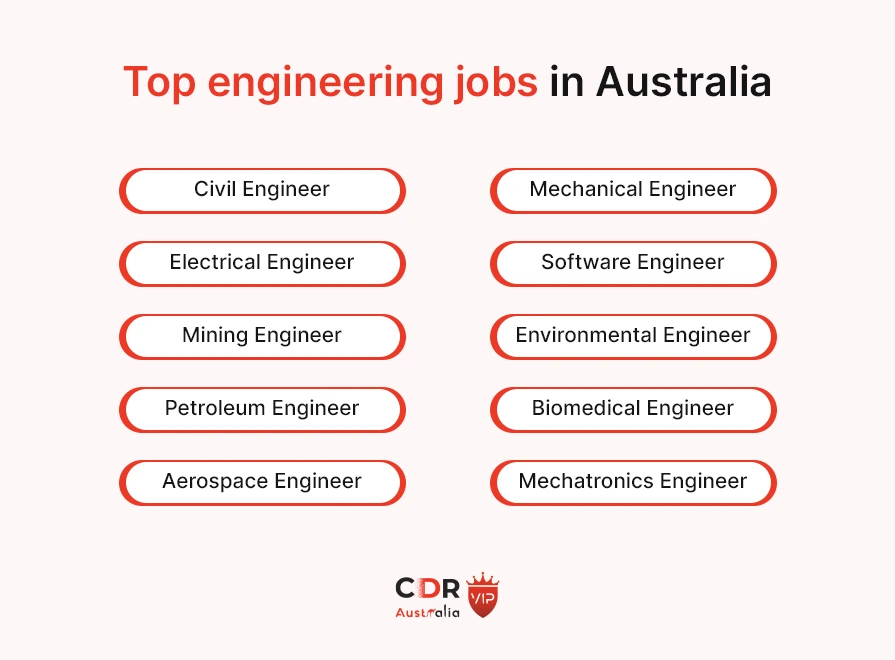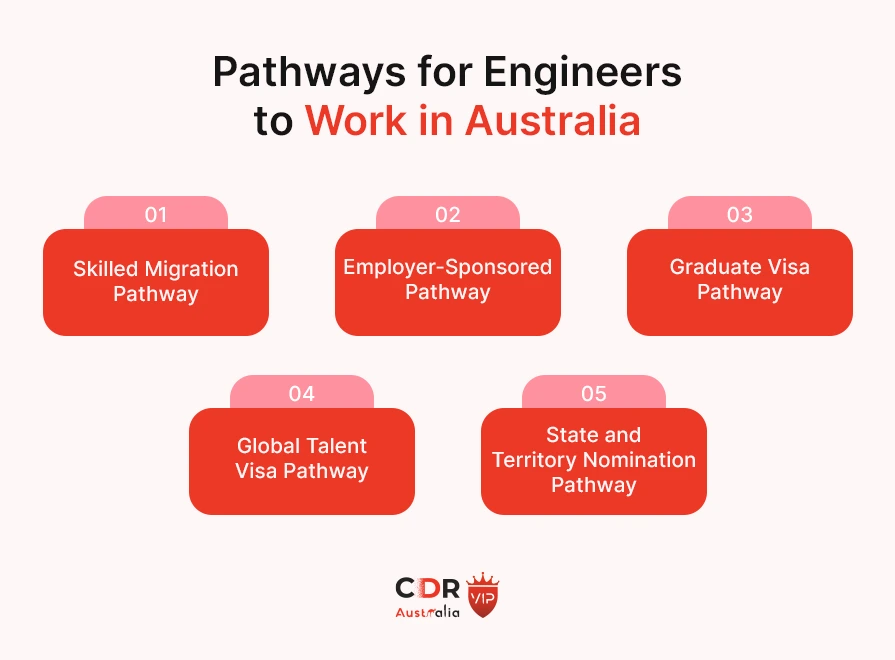Top Engineering Jobs in Australia. Full Guide

Top Engineering Jobs in Australia. Full Guide
Australia is an ideal location for engineers seeking fulfilling professional prospects. Australia presents engineers with lucrative job opportunities throughout different sectors and pays attractive salaries and an excellent standard of living. The Australian infrastructure and energy sectors, mining operations, and technological developments demand engineers, which makes this profession highly desirable.
The following blog presents information about Australia’s most in-demand engineering roles, their current market value, and anticipated expansion opportunities. This guide will supply important information about the prime engineering disciplines for future engineers and anyone seeking to move to Australia.
🔑 Key Highlights
- Engineering jobs in civil and software sectors continue to prosper in infrastructure, energy, mining and tech markets, which establish broad prospects for Australian and international professionals.
- Best Engineering professionals working in Australian software and mining, together with the electrical field, earn between AUD 80,000 and AUD 200,000 annually and have outstanding prospects for professional growth.
- Qualified engineering applicants can use different Australian migration pathways that combine GSM, TSS and ENS and the Global Talent Visa to get engineering jobs and permanent residency.
- Engineers encounter defined professional advancement pathways because engineering roles are in demand in the future.
- The best engineering jobs in Australia align with upcoming market directions through government-sponsored initiatives.
Top engineering jobs in Australia

1. Civil Engineer
Civil engineers direct their expertise towards designing and constructing all infrastructure components, from roads and bridges to buildings and water supply systems. Due to its vital role in urban expansion, infrastructure improvement, and transportation developments, civil engineering is the most sought-after profession in Australia.
Demand in Australia
The Australian government spends significant funds on constructing roads, railways, and public facilities. Civil engineering demand skyrocketed as several major projects, including Sydney Metro, Melbourne West Gate Tunnel, and Brisbane Cross River Rail, emerged.
Salary and Career Growth
Average Salary: AUD 80,000–150,000 per year
Organisations provide excellent professional progression options that lead civil engineers towards project management roles, consulting employment, and government positions.
2. Mechanical Engineer
Mechanical engineers build mechanical systems for automotive and aerospace applications, energy operations, and manufacturing facilities through development and maintenance activities. Specialised knowledge from these experts enables multiple sectors to achieve innovative solutions and operational efficiency systems.
Demand in Australia
The modern operations of Australia rely on mechanical engineers since they create advanced systems for manufacturing businesses while also designing machinery for mining industries and supporting renewable energy foundations. The growing need for automated systems, together with sustainable energy development, drives up their market demand.
Salary and Career Growth
Average Salary: AUD 75,000–140,000 per year
Professionals can achieve strong career advancement opportunities, which stand especially high in the mining sector and the automation and renewable energy domains.
3. Electrical Engineer
As professionals, electrical engineers manage the creation and maintenance of electrical frameworks that power generation systems and support telecommunications and electronic tools. The Australian market experiences rapid growth in smart grids and renewable energy projects, thus driving up demand for this industry.
Demand in Australia
The national effort to expand renewable energy technology, particularly wind and solar power, has fueled strong employment demand for electrical engineers in Australia. Industrial demand continues to grow because of mounting structural trends towards automation and smart technology adoption in manufacturing facilities.
Salary and Career Growth
Average Salary: AUD 85,000–150,000 per year
Career Growth: High, with opportunities in renewable energy, telecommunications, and smart technology industries.
4. Software Engineer
Software engineers produce, enhance and supervise the creation of software applications that serve banking institutions, healthcare facilities and technology organisations. The rise of digital transformation drives Australia to perform active recruitment of software engineers into essential professional roles.
Demand in Australia
The expanding tech sector of Australia, together with active growth in AI research and cybersecurity and cloud computing domains, generates heightened demand for software engineers. The technological startups Atlassian and Canva, together with other innovative tech enterprises, push forward both innovation and job opportunities within their markets.
Salary and Career Growth
Average Salary: AUD 90,000–170,000 per year
Career development thrives at a high standard, allowing professionals to pursue work in AI together with cloud computing cybersecurity and fintech fields.
5. Mining Engineer
The main duties of mining engineers entail safe resource extraction operations that are also efficient. The abundance of minerals in Australia enables mining engineering to become a highly paid and secure branch of engineering.
Demand in Australia
Australia ranks among the globally leading nations that produce coal alongside iron ore and gold. The mining industry maintains strong employment prospects, mainly in Queensland and Australia, because these states run most mining operations.
Salary and Career Growth
Average Salary: AUD 100,000–180,000 per year
The opportunities for career advancement are promising, particularly within mining centres, which include Perth and Brisbane.
6. Environmental Engineer
Environmental engineers conduct professional work that involves sustainable development, along with pollution prevention initiatives and waste disposal management. Environmental engineers play a key role in helping decrease industrial and infrastructure projects negative impact on the environment.
Demand in Australia
The rising number of sustainability and climate change regulations from the government has boosted the demand for environmental engineers in the marketplace. Professionals working in renewable energy can access multiple employment possibilities because of this sector.
Salary and Career Growth
Average Salary: AUD 80,000–130,000 per year
Environmental engineers benefit from excellent career advancement possibilities that exist within government institutions, consulting organisations and renewable power industries.
7. Petroleum Engineer
Petroleum engineers focus on extracting oil and gas resources by improving drilling practices to achieve maximum operational effectiveness in producing energy. The need for petroleum engineers continues to grow in Australia because of its substantial oil and gas resources, even though worldwide energy sectors have started adopting renewable systems.
Demand in Australia
Australian oil and gas corporations like Woodside and Santos maintain their employment of petroleum engineers to support their exploration and production activities. The liquefied natural gas sector specifically creates the most employment opportunities in this sector.
Salary and Career Growth
Average Salary: AUD 110,000–200,000 per year
Professional advancement opportunities are strong within the LNG sector and the offshore drilling field.
8. Biomedical Engineer
Engineers who specialise in biomedical fields create medical tools along with artificial body parts and hospital technologies that help medical staff deliver better care to patients. The Australian healthcare industry expansion has driven up the need for biomedical professionals.
Demand in Australia
Medical technology needs and demographic changes in the population pattern have opened up new career paths for biomedical engineers. Research and development work that occurs in Australia strengthens employment opportunities throughout the market.
Salary and Career Growth
Average Salary: AUD 75,000–130,000 per year
Career Growth: Excellent, with opportunities in hospitals, research institutions, and medical device companies.
9. Aerospace Engineer
Aerospace engineers focus on developing aircraft systems, together with spacecraft systems, as well as defence system structures. Aerospace engineering represents an exciting career choice in Australia because of the ongoing progress in aviation technology, together with space exploration initiatives.
Demand in Australia
The defence and space industries in Australia demonstrate growth through the local operations of international companies Boeing and Lockheed Martin. The Australian Space Agency develops programmes that drive up the need for aerospace engineers throughout Australia.
Salary and Career Growth
Average Salary: AUD 90,000–160,000 per year
Career Growth: High, with opportunities in defence, commercial aviation, and space technology.
10. Mechatronics Engineer
Mechatronics engineers unite concepts from software engineering, combined with mechanical engineering and electrical engineering, to create automated systems combined with smart technologies and with robotic frameworks.
Demand in Australia
Small businesses and large organisations across the defence industry, manufacturing sector, and healthcare space heavily depend on mechatronics engineers due to the rising prominence of automation, artificial intelligence and Industry 4.0 technologies.
Salary and Career Growth
Average Salary: AUD 80,000–140,000 per year
Career Growth: Excellent, with opportunities in robotics, automation, and AI-driven industries.
Know more: Top 10 most demanded engineering fields in Australia 🤔🤩
Pathways for Engineers to Work in Australia

Australia provides various immigration channels that allow engineers who are new graduates, as well as experienced professionals and talented migrants, to work in the country. Engineering professionals seek Australia because the country needs more engineers to work in infrastructure and mining, together with energy development and technology innovations.
These represent the main opportunities that enable engineers to find work and residency in Australia.
1. Skilled Migration Pathway
a. General Skilled Migration (GSM) Visas
The government has listed engineers on the Medium and Long-term Strategic Skills List, which establishes their high demand in the Australian market. The skilled migration programmes become open to engineers because they qualify under the Medium and Long-term Strategic Skills List (MLTSSL).
Engineers can apply for subclass 189 and subclass 190 visas together with subclass 491 visas under the skilled migration category.
The Skilled Independent Visa (Subclass 189) provides permanent residency to self-supported professional engineers. Engineers seeking permanent residency can apply for a point-based visa that leads to this outcome.
Skilled Nominated Visa (Subclass 190)—Requires state or territory nomination and grants permanent residency.
The Skilled Work Regional (Provisional) Visa (Subclass 491) functions as a temporary work visa for engineers who can stay and work in regional Australia for five years while having the chance to transition to permanent residency.
Eligibility Requirements:
- Engineers Australia evaluates engineering skills through a process called Skills Assessment to determine the qualifications and work experience of candidates.
- Points Test: Based on age, education, work experience, and English proficiency.
- The requirement to demonstrate proficiency in the English language includes tests from IELTS, PTE and TOEFL.
- Potential candidates need to submit their Expression of Interest (EOI) portal application in SkillSelect.
2. Employer-Sponsored Pathway
a. Temporary Skill Shortage (TSS) Visa (Subclass 482)
Companies in Australia maintain the right to seek foreign engineering professionals as substitutes for domestic candidates. Engineering professionals approved by the authority can work for a maximum period of four years under this recruitment programme.
Qualified candidates can apply for the Short-Term Stream visa when their skills match the occupations specified in the Short-Term Skilled Occupation List.
The Medium-Term Stream under subclass 482 of SkillSelect lasts for four years of employment for professionals within occupations on the Medium and Long-Term Strategic Skills List (MLTSSL).
b. Employer Nomination Scheme (ENS) Visa (Subclass 186)
Through this visa, engineers can work in Australia permanently when their prospective employer acts as their sponsor.
Direct Entry Stream—Requires skills assessment and at least 3 years of relevant work experience.
The Temporary Residence Transition Stream makes itself available to Subclass 482 visa holders who maintain employment with the same employer for a period of 3 years.
The Regional Sponsored Migration Scheme (RSMS) Visa (Subclass 494) serves professionals who seek employment positions in designated Australian geographical areas.
Engineers who want to work in regional Australia can seek this visa. The visa requires staff sponsorship, along with allowing candidates to gain permanent residency benefits.
3. Graduate Visa Pathway
a. Temporary Graduate Visa
International students who finish engineering degrees at Australian educational institutions (bachelor’s or master’s level) can get this visa to receive up to 4 years of work experience.
b. Professional Year Program
International engineering graduates need to participate in the 44-week Professional Year in Engineering programme to build their Australian work experience and professional capabilities. Students who finish the PYP can obtain extra points as part of their permanent residency visa application process.
4. Global Talent Visa Pathway
a. Global Talent Visa (Subclass 858)
The Global Talent Visa (subclass 858) enables qualified candidates in AI, renewable energy, cybersecurity and advanced manufacturing to obtain this visa.
- No employer sponsorship is required
- Priority processing
- Direct pathway to permanent residency
5. State and Territory Nomination Pathway
Each region of Australia operates state nomination programmes for both the Skilled Nominated Visa (Subclass 190) and the Skilled Work Regional Visa (Subclass 491). The visa requirements differ per state because some require residents to work locally, combined with various English language requirements.
Conclusion
Engineering professionals can find multiple career opportunities that exist throughout Australia’s job market. The country gives engineers in all engineering fields good salaries and supports professional progress and stable employment prospects.
The next period represents an ideal opportunity for you to join engineering fields in Australia and capitalise on its fast-growing employment opportunities.
FAQs
1. Which engineering jobs are in high demand in Australia?
Some of the engineering jobs that are in high demand in Australia are as follows:
- Civil Engineers
- Software Engineers
- Electrical Engineers
- Mechanical Engineers
2. Is it easy to get a job in Australia as an engineer?
Getting a job in Australia depends on your qualification, experience and interest.
3. Which jobs get PR in Australia?
In Australia, permanent residency (PR) is granted to skilled workers whose occupations are in demand.
The Skilled Occupation List (SOL) determines which jobs qualify for PR under various visa programmes.
4. Do engineers get PR in Australia?
Yes, engineers can get permanent residency (PR) in Australia through the Skilled Migration Programme, as engineering is a high-demand occupation.


